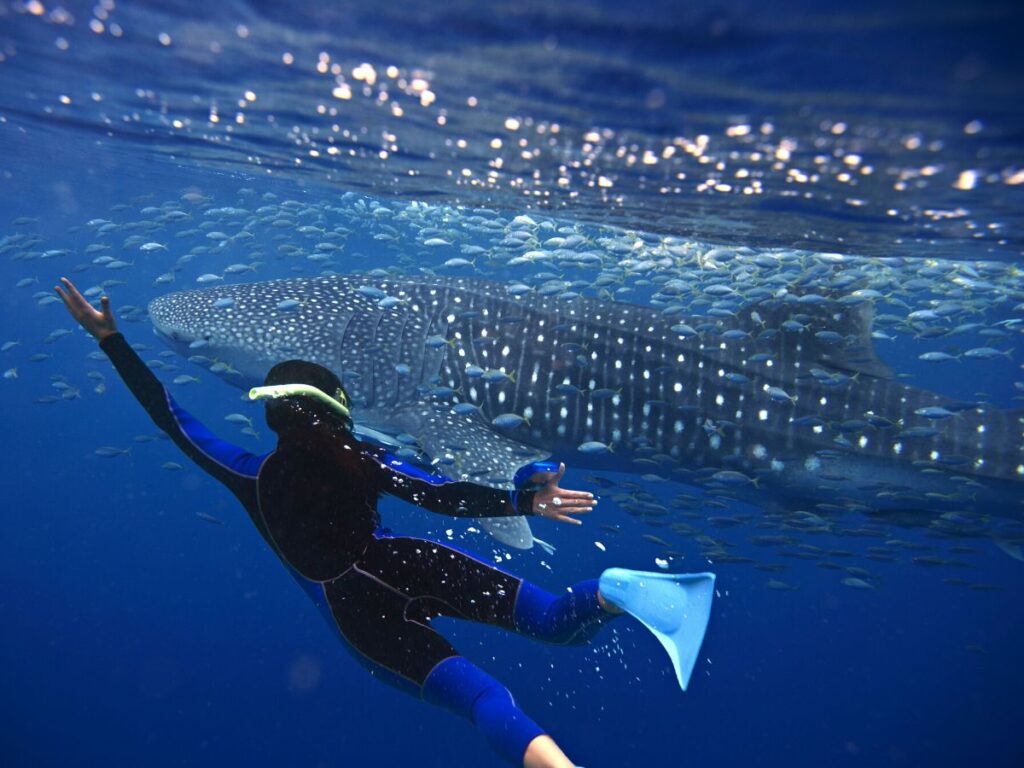Swimming with whale sharks, the world’s largest fish, is one of the most popular activities in the world, making tourists want to come to visit every year. During the summer months, different sections of the Caribbean sea have one of the biggest concentrations of this animal in the world, making it ideal for interacting with it. Swimming with whale sharks is a highlight for many people, and it is highly sold all over the world. Although it is particularly popular in the south, there are some other great places to encounter these majestic animals, so if you’re looking for the most idyllic place to meet such magnificent creatures, we’ve compiled the best swim with whale sharks in Mexico seasons.
THIS IS THE BEST TIME TO SWIM WITH WHALE SHARKS IN CANCUN
Because of the high number of whale sharks that visit Cancun, it is unquestionably one of the greatest places to get up close and personal with these massive and friendly sea giants. Anytime is a terrific time to visit this lovely city, but it’s even better during Whale Shark season in Cancun.
Whale shark season in Cancun runs from mid-May to mid-September, with a peak season from late June to mid-August, a time when you may see and swim with up to 150 whale sharks. Nevertheless, despite having one of the highest whale shark populations in Mexico and the globe, Cancun’s low whale shark season is from May to June and mid-August to September, and since whale sharks are a slow-moving animal that tends to stay longer in our waters, these summer months are to most idyllic to swim with whale sharks in Mexico.
Whale sharks are the largest fish in the sea, despite their size, they are quite calm animals interested in eating only small marine life, making swimming with whale sharks a safe and enjoyable experience; so, If you want to enjoy this once-in-a-lifetime event, we offer an incredible Cancun whale shark snorkeling tour that guarantees an amazing encounter, as well as a high possibility to observe and swim alongside other creatures such as turtles and dolphins.
VISIT DURING THE BEST WHALE SHARK SEASON HOLBOX
The northern tropical island of the Yucatan peninsula, “Holbox,” is a favorite spot for whale sharks to breed and feed on the massive amounts of plankton attracted by the warm waters of the Caribbean Sea.
Every year, the Holbox whale shark season runs from June to mid-September, and while these species can be seen since early May, you might not see as many since they’re still arriving. However, throughout the summer months, you will be able to observe a large number of these enormous beasts, particularly during the peak season from July to August, when the number of whale sharks is at its highest.
As previously stated, summertime is the best season to enjoy these encounters, not only because of the quantity but also because the weather in this region is generally excellent and predictable, with bright skies and a calm warm breeze, though there is always a mild chance of a radical change in winds, which can affect visibility and the trip may not go as smoothly as on a sunny day, so we could say that the windiest weeks of the season tend to be the first three or four and are followed by the calmest weeks.
THIS IS THE BEST TIME TO VISIT AT LA PAZ WHALE SHARK SEASON
La Paz, the largest city in Baja California, and the state capital, roughly two hours away from Cabo San Lucas, attracts over 800 marine species due to its abundant pelagic environment. One of them is the Whale shark a gigantic voracious consumer of plankton and krill, the main factor of their presence.
Annually, the whale-shark season in La Paz lasts from October to May, and since they gather in large numbers to feed on the traveling plankton, whale sharks can be seen almost all year long, but the peak season (which lasts from November to April), is the greatest time to encounter these creatures.
Something pretty important to take in mind is the weather, during La Paz whale shark season visibility can reach 60 feet (18 meters) and water temperatures can reach the 80s F (26 C). During the early months of the season, pelagic aggregations and small invertebrates swarm the area, and the water temperature drops to the low 60s (15 C) in January.
If you found this article helpful, visit our Instagram and check out all of our amazing tours.

